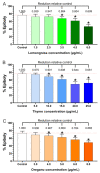Essential Oils Produce Developmental Toxicity in Zebrafish Embryos and Cause Behavior Changes in Zebrafish Larvae
- PMID: 37893194
- PMCID: PMC10603861
- DOI: 10.3390/biomedicines11102821
Essential Oils Produce Developmental Toxicity in Zebrafish Embryos and Cause Behavior Changes in Zebrafish Larvae
Abstract
Essential oils have gained significant popularity in various industries due to their biological properties, but their potential toxic effects on living organisms have been poorly investigated. This study aimed to evaluate the effects of lemongrass, thyme, and oregano essential oils on zebrafish embryos and larvae as animal models. Embryos were exposed to different concentrations of essential oils, and various endpoints were assessed, including epiboly, mortality (LC50), morphometry, and behavioral changes. All three essential oils reduced epiboly, affecting embryonic development. LC50 values were calculated for lemongrass (3.7 µg/mL), thyme (14.4 µg/mL), and oregano (5.3 µg/mL) oils. Larvae exposed to these oils displayed morphological defects, including growth reduction, spinal deformation, pericardial edema, eye size reduction, and reduced swim-bladder inflation. Morphometric analysis confirmed reduced larval length at higher oil concentrations. Essential-oil exposure altered zebrafish larval swimming behavior, with lemongrass oil reducing dark-cycle activity and oregano oil increasing light-cycle activity, suggesting neurodevelopmental toxicity. These findings illustrate the adverse effects of these oils on zebrafish embryos and larvae and reveal essential-oil toxicity, indicating careful use should be considered, particularly during pregnancy.
Keywords: embryogenesis; essential oils; toxicology; zebrafish.
Conflict of interest statement
The authors declare no conflict of interest.
Figures





References
-
- Mensah M.L.K., Komlaga G., Forkuo A.D., Firempong C., Anning A.K., Dickson R.A. Herbal Medicine. IntechOpen; London, UK: 2019. Toxicity and Safety Implications of Herbal Medicines Used in Africa.
Grants and funding
LinkOut - more resources
Full Text Sources

